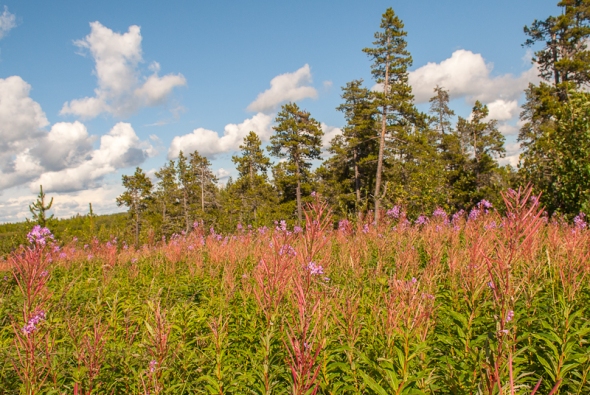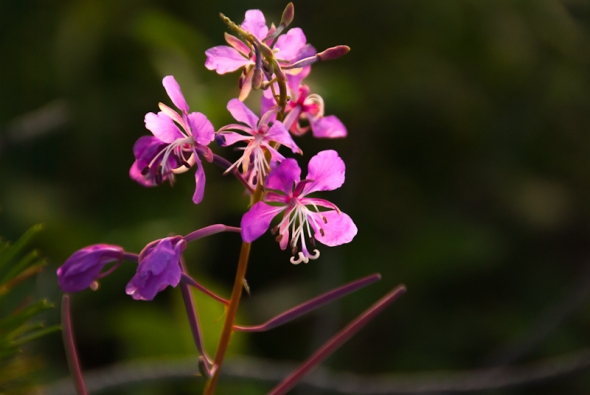Fireweed
Epilobium angustifolium, also Chamerion angustifolium
Other common names: Great Willowherb, Rosebay Willowherb(GB), Blooming Sally, and Common, Perennial and Narrow-Leaved Fireweed
Fireweed is the floral emblem of the Yukon.
It grows throughout the temperate Northern Hemisphere.
Fireweed grows in my gardens.
I let it.
It’s beautiful.
The forty or so years since the forest was cleared to build my neighbourhood has not been enough to discourage this stalwart troop of botanical disaster relief. In fact generations would not be enough, as London discovered when firewood appeared to console and heal the (destroyed) city after World War II. It became known then as ‘Bombweed’ since it speedily transformed bomb craters into sunken gardens.
My garden is disturbed ground. A pioneer species, Fireweed appears wherever the earth has been scraped, or especially burned, leaving exposed soil and an open canopy letting in lots of light. Its rhizomes can extend to about 45 cm. deep, knitting and holding the soil, preventing erosion while other more slowly growing vegetation can become established. The rhizomes are so tenacious they often survive forest fires. They survived the 1980 Mount St. Helens eruption.
The flowers vary in colour from pink through purple and rarely white. They bloom on their raceme from the bottom to the top, transforming the profile of plant as they fade and morph into long curved seed-pods.
About 200-500 gossamer winged seeds are produced within each seedpod, up to 80,000 per plant. These seeds can survive up to two years – they do not go dormant – and can travel from 100-300 kilometres on their plumes in the right conditions.
In autumn, the first frosts paint the leaves a rich red, changing the swaths of purple-pink flowers to compliment the firey tamaracks and currant bushes.
Even the most botanically uninterested residents of Fireweed country recognize this plant once it’s in bloom, but in spring and fall it might help to remember that the Fireweed has a uniquely circular vein pattern on its narrow leaves. (The latin angusti, means narrow and folium, means leaf.)
Fireweed is very abundant in the Swan Hills, quickly colonizing after forest fires and logging. It has a relatively long blooming season and is an important source of nectar for honeybees and hummingbirds, and food for moose, deer and hares.
Yet another important role that Fireweed has played throughout its range is its historical importance as food and medicine. All parts are edible. The leaves contain Vitamin A & C and can be eaten fresh or cooked. Like most greens can become somewhat bitter with age. Be aware, though that over-indulgence can be slightly laxative for some people. Use of the flowers range from simple salad garnish to candies and the ambrosial Firewood honey has become a popular commercial product in Canada & Russia.
Medicinally the plant has been used for worm medicine, stomachaches and poultices. The Dena’ina mixed cooked plants into the food they gave to their sled dogs.
Fireweed is so abundant it has been put to such a humble use as surface for cleaning fish and probably rush-like flooring. The stem fibres were used as thread by many native North American peoples.
Even in winter and early spring this plant is recognizable, decorating the clearings with the intricate tracery of its remains.
Selected Resources:
U.S. Forestry Service Study (very detailed)
Northern Bushcraft: Foraging in the Pacific Northwest
Montana Plant Life
Plants for a Future
Plants of the Western Boreal and Aspen Parkland
Sweetness and Light
















What a great post, Cindy. I’ve always been a fan of fireweed (which is why I’m writing my own take on it as we speak), but there were a few things I still had yet to learn. Thanks for such a detailed account. I don’t think I’ve ever seen one that’s gone to seed like that and our winter plants never look that lacey (probably because of our winds).
Stunning pictures. I especially love the light in the second and third ones. As always, a wonderful exploration.
August 2, 2012 at 6:26 pm
I’m looking forward to seeing your post, Heather. You know I love your artwork and you always have something to teach me no matter how much I think I already know about a subject. Thank you for the comment and the compliments.
August 2, 2012 at 6:36 pm
Cindy, really informative post and those photos are great. We have fireweed here too. I just didn’t know what it was. I need to keep an eye on it so I’ll see those seed pods in fall.
August 2, 2012 at 7:32 pm
Once you start noticing them, you’ll see them everywhere. They don’t stay in that stage for long though. They get ‘hairy’ quite quickly. Thanks for stopping by to comment, Sybil.
August 3, 2012 at 7:47 pm
Pingback: Flowery spotlight: Fireweed. « Flowery Prose
Pingback: Sweetness and Light « The Naturalist's Miscellany
Pingback: Parkway Drive, Crescent City 95531 « seapunk2
Reblogged this on mukeshpatel23.
September 10, 2012 at 11:57 am
Everything OK ? Is this your most recent post ?
December 10, 2012 at 6:22 pm
Sadly, yes it is Sybil. Thanks for asking. Everything’s just fine – just consumed with work and family matters. I have lots I want to post…someday. Hoping things will slow down after Christmas – but no guarantees.
December 10, 2012 at 7:56 pm
I missed this post. What an all around beautiful plant! Great photographs and information too, Cindy!
(Miss you!)
January 28, 2013 at 10:11 pm
Cindy, you haven’t posted in ages. Hope all is well.
February 7, 2013 at 3:19 pm
Pingback: SATURDAY FLOWERS – old shots topic | Sell1buy
Pingback: Puppy’s First Hike | oakleighexplorations